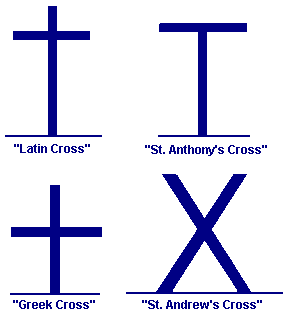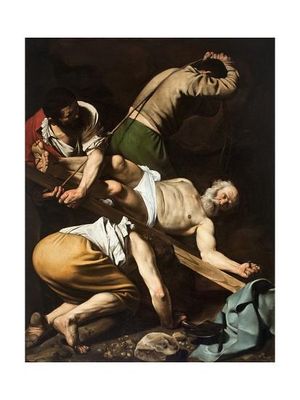Crosses
There are four primary shapes of crosses
The St Anthony's Cross is also known as the Tau Cross (because it resembles the Greek letter Tau)
The Latin Cross is also known as St Georges Cross
Crucifixion
Crucifixion (noun) [and crucify (verb)] is an ancient method of execution, where the condemned is tied or nailed to a large wooden cross and left to hang until dead.
This form of execution was widely practiced in Ancient Rome and in neighboring Mediterranean cultures; similar methods were invented in the Persian Empire.
Details of crucifixion
Crucifixion was almost never performed for ritual or symbolic reasons outside of Christianity, but usually to provide a death that was particularly painful (hence the term excruciating, literally "out of crucifying"), gruesome (hence dissuading against the crimes punishable by it) and public (hence the metaphorical expression "to nail to the cross"), using whatever means were most expedient for that goal. Crucifixion methods varied considerably with location and time period.
The Greek and Latin words corresponding to "crucifixion" applied to many different forms of painful execution, from impaling on a stake to affixing to a tree, to an upright pole (what some call a crux simplex) or to a combination of an upright (in Latin, stipes) and a crossbeam (in Latin, patibulum).
If a crossbeam was used, the condemned man was forced to carry it on his shoulders, which would have been torn open by flagellation, to the place of execution. A whole cross would weigh well over 300 pounds (135 kilograms), but the crossbeam would weigh only 75-125 pounds (35-60 kilograms). The Roman historian Tacitus records that the city of Rome had a specific place for carrying out executions, situated outside the Esquiline Gate, and had a specific area reserved for the execution of slaves by crucifixion. Upright posts would presumably be fixed permanently in that place, and the crossbeam, with the condemned man perhaps already nailed to it, would then be attached to the post.
The person executed may sometimes have been attached to the cross by ropes, but nails are mentioned in a passage of Josephus, where he states that, at the Siege of Jerusalem (70 AD), "the soldiers out of rage and hatred, nailed those they caught, one after one way, and another after another, to the crosses, by way of jest", and in John 20:25. Objects, such as nails, used in the execution of criminals were sought as amulets.
Cause of death
The length of time required to reach death could range from a matter of hours to a number of days, depending on exact methods, the health of the crucified person and environmental circumstances.
A theory attributed to Pierre Barbet holds that the typical cause of death was asphyxiation He conjectured that when the whole body weight was supported by the stretched arms, the condemned would have severe difficulty inhaling, due to hyper-expansion of the lungs. The condemned would therefore have to draw himself up by his arms, or have his feet supported by tying or by a wood block. Indeed, Roman executioners could be asked to break the condemned's legs, after he had hung for some time, in order to hasten his death. Once deprived of support and unable to lift himself, the condemned would die within a few minutes. If death did not come from asphyxiation, it could result from a number of other causes, including physical shock caused by the scourging that preceded the crucifixion, the nailing itself, dehydration, and exhaustion.
Experiments by Frederick Zugibe have revealed that, when suspended with arms at 60° to 70° from the vertical, test subjects had no difficulty breathing, only rapidly-increasing discomfort and pain. This would correspond to the Roman use of crucifixion as a prolonged, agonizing, humiliating death. Zugibe claims that the breaking of the crucified condemned's legs to hasten death, as mentioned in John 19:31-32, was administered as a coup de grâce, causing severe traumatic shock or hastening death by fat embolism. Crucifixion on a single pole with no transom, with hands affixed over one's head, would precipitate rapid asphyxiation if no block was provided to stand on, or once the legs were broken.
It was, however, possible to survive crucifixion, and there are records of people who did. The historian Josephus, a Judaean who defected to the Roman side during the Jewish uprising of AD66 - 72, describes finding two of his friends crucified. He begged for and was granted their reprieve; one died, the other recovered. Josephus gives no details of the method or duration of crucifixion before their reprieve.
Chat rooms • What links here • Copyright info • Contact information • Category:Root

